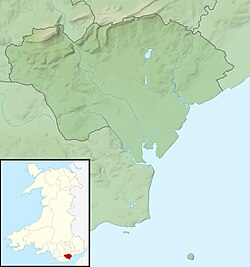Twmpath Castle
Twmpath Castle,[4][2] also known as Twmpath Motte (Welsh: Caer Cynwrig),[1][2] is a medieval motte on the southern slope of Wenallt Hill near Rhiwbina in Cardiff, Wales, which is a scheduled monument.[5][3] ToponymyTwmpath is a Welsh word literally meaning a hump.[6] Caer Cynwrig are both Welsh words. Caer (Old Welsh: cair or kair) is a placename element meaning a fortification, a camp, an inclosure, a wall or mound of defence,[7] while Cynwrig in Old Welsh means high hill.[2] HistoryThe motte-and-bailey castle dates back to the middle Ages from about 1066 to 1540.[3] Originally Twmpath Castle was a Welsh camp called Caer Cynwrig, which was captured and occupied by the Normans and became the third largest motte in the Lordship of Glamorgan.[8] Robert Fitzhamon founded Cardiff Castle and used the old Cardiff Roman Fort to construct it.[9] Cardiff Castle was the capital of the Lordship of Glamorgan and Twmpath Castle formed one of a string of fortifications used to defend the newly conquered town of Cardiff with a ring of eight smaller earth and timber castles, Caerau Hillfort, Morganstown Castle Mound, Castell Coch and Whitchurch (known as Treoda), Cae’r Castell, near St Mellons and Rumney Castle.[9] Present dayToday the site is overgrown and stands approximately 25 ft (7.6 m) high and 130 ft (40 m) around.[8] The top is 16 m (52 ft) in diameter. The motte is surrounded by a ditch, which varies in depth between 1 m (3.3 ft) to 1.2 m (3.9 ft) and width between 4 m (13 ft) and 5 m (16 ft).[3] Cadw has described the monument as being of "National importance for its potential to enhance our knowledge of medieval defensive practices.[3] The monument is well-preserved and an important relic of the medieval landscape.[3] It retains significant archaeological potential, with a strong probability of the presence of both structural evidence and intact associated deposits."[3] It was designated as a scheduled monument on 23 July 1930.[3] LegendsLegend has it that it is a burial mound erected about 1089 for Iestyn ap Gwrgan, Lord of Glamorgan.[10] The other legend says that the Devil piled up some earth in the form of a mound.[10] See also
References
Further reading
External links
|
||||||||||||||||||||||||||
Portal di Ensiklopedia Dunia















